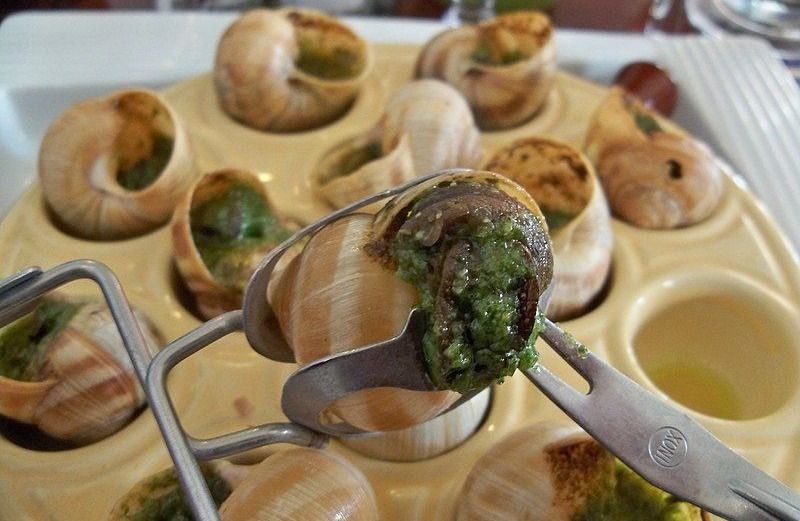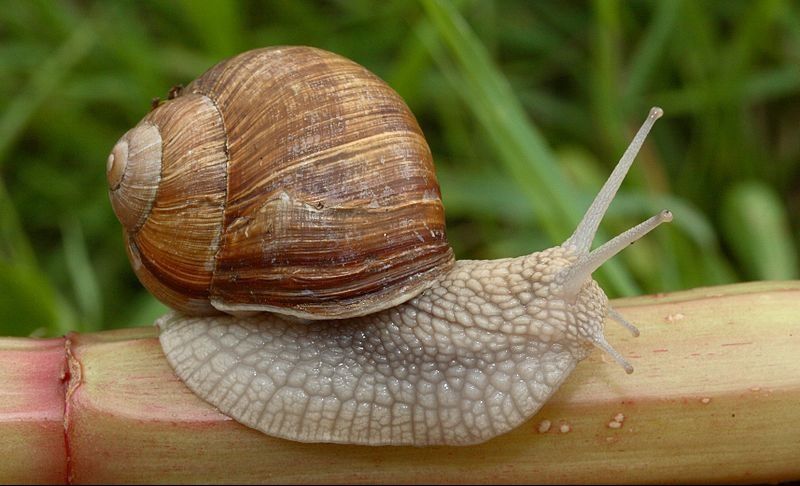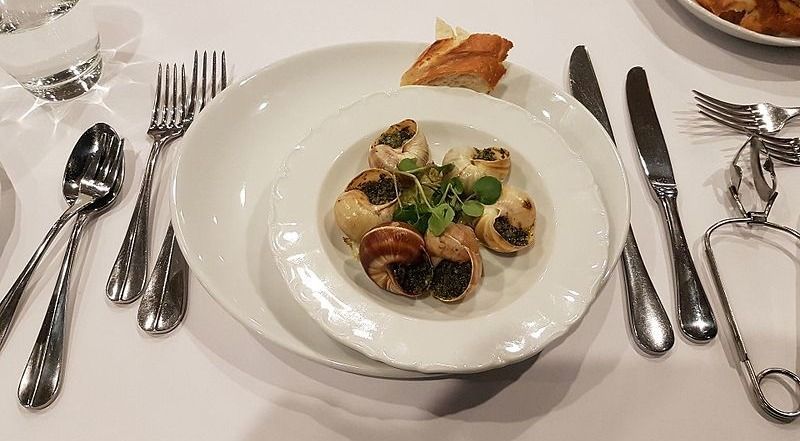Escargot: Unveiling the Snail World of Luxurious Delicacy
The traditional culinary significance of escargots, combined with their distinctive umami flavor profile, contribute to their premium pricing in global cuisines.

Does the idea of consuming snails make you shudder? It might seem odd at first, but snails stand as one of the most flavorful, environment-reflective, and nutrient-packed staples in French culinary arts.
While they might come off as daunting initially, snails truly embody the epitome of French culinary pleasure.
What is Escargot?
Escargot is the French word for snail, but in culinary terms, it specifically refers to edible land snails that have been prepared for consumption, often as a delicacy.
Traditionally, escargot is prepared by removing the snail from its shell, cleaning and cooking it (often in garlic butter, chicken stock, or wine), and then placing it back into the shell for serving.
It is typically served with escargot's special fork and tongs.

The Most Expensive Snail Varieties
Helix pomatia (Burgundy Snail or Roman Snail)
Recognized as the crown jewel in the world of escargots, the Helix pomatia, or the Roman/Burgundy snail (escargot de Bourgogne), boasts its roots in the nutrient-rich regions of Central and Eastern Europe.
Celebrated for its rich texture and deep flavor, it epitomizes culinary excellence. Harvested primarily between May and June after spring's rejuvenation, these snails are at their prime, with earlier-collected ones allowed a purging phase.
In the realm of delicacies, the Burgundy snail reigns supreme.
H. lucorum, known as the Turkish snail (escargot du turc), along with Cornu aspersum, referred to as the common garden snail (escargot petit gris), are both consumed delicacies. These, along with a select few other species, are both sourced from the wild and cultivated on snail farms.
History of Escargot
The rise of snails in French gourmet circles can be traced back to a historic encounter between Tsar Alexander and Napoleon's key diplomat, Prince Talleyrand.
Legend has it that during a 1814 visit to Burgundy, Tsar Alexander's entourage unexpectedly stopped at a restaurant. The chef, Antonin Carême, seemingly unprepared, turned to his garden's snails as a last-minute solution.
To mask the natural flavor and enhance aesthetics, he introduced garlic, parsley, and butter to the dish. After returning to Russia, the Tsar's fond memory of these "Burgundy snails" persisted.
However, another version of the tale suggests that Talleyrand, while in Paris, aimed to dazzle the Tsar with a unique dish.
When his chef's wine-cooked snail proposition felt too simple, Talleyrand directed him towards the garlic, butter, and parsley preparation, establishing what we now know as the classic "Burgundy-style" escargot.
Regardless of its true genesis, this dish soared in popularity and has become an enduring favorite in French cuisine.

What's the Price Tag on Escargot?
Dining out? A serving of 6-12 escargots in a up-scale restaurant can set you back around $50, influenced by the establishment's caliber and locale.
However, for a can containing a pound of deshelled escargot, which typically holds about 50-80 snails, the cost would be around $40- $50.
Why is Escargot so Expensive?
Overwhelming Demand Outpacing its Supply
The dwindling escargot numbers have amplified their global appeal as a luxury item.
Annually, the French consume around 40-50 thousand tons of snails, with nearly half during the Christmas season.
Despite their love for this delicacy, France heavily imports from Eastern Europe, the Balkans, and countries like Greece and Turkey due to soaring demand.
Meanwhile, in the U.S., where escargots feature prominently in over 200 Michelin Star restaurants and 450 renowned resorts, only two snail farms are USDA-certified, highlighting a supply-demand disparity.
Farming and Harvesting
Burgundy snail are typically harvested by hand, which is labor-intensive.
Snails require a humid environment to produce the necessary mucus for movement. Warmth is also vital, with the best temperatures ranging between 16-22 °C.
Lime-rich soil, sourced from chalk and limestone, aids snail growth and heat retention. Proper containment, using barriers like wood or mesh, is vital to protect snails from predators.
Additionally, some farms employ sun-blocking cloths. Managing a Burgundy snail farm necessitates a proactive, hands-on approach.
Managing a Burgundy snail farm demands a hands-on approach, overseeing both specialized tasks and daily maintenance.
Quality and Rarity
The best escargot varieties, especially the Roman Snail, also known as the Burgundy Snail, has become scarce and is now protected in France due to habitat disruption from modern drainage initiatives.
Recognized as one of the most iconic edible snails, its population in France was once endangered by extensive commercial harvesting.
To safeguard the species and ensure breeding, collection for culinary purposes is now limited to the period between July and March. Additionally, only snails measuring over 3 cm in diameter can be gathered.
Purging Process and Preparation
Before cooking, snails are "purged" to clear their digestive systems, which entails a specific diet for several days.
Preparing snails for consumption is intricate: post-harvest, due to their distinct anatomy, they aren't immediately ready to cook. They're kept unfed for 8-12 days for purification.
After this fasting period, they're meticulously rinsed and then prepped for cooking, freezing, or canning.
Import and Export Costs
U.S. restaurateurs source escargots from Europe, South America, Africa, and Asia to satisfy growing demand.
Diverse snail varieties grace their menus, but international imports come at a price. Custom duties, preservation costs, and markups contribute to the upscale pricing of escargots in the U.S.
Flavor Profile
Escargot has a tender, chewy texture akin to mushrooms or clams. Their flavor is earthy, slightly nutty, and is greatly enhanced by the buttery, garlicky sauces they're often prepared in.
Interesting Facts about Escargot:
- The correct pronunciation for "escargots" is ess-car-GOH, with the 's' at the end being silent.
- Beyond France, snails are savored in diverse regions like Spain, Portugal, Crete, Tunisia, and various Asian countries.
- If you're a fan of seafood delights like mussels, clams, or squid, chances are you'll develop a palate for escargots too.
- From escargot's health perspective, escargot stands out: it's protein-rich, has minimal fat, and offers essential fatty acids, magnesium, and selenium.
- Mark your calendars: Every May 24th is celebrated as National Escargot Day in the U.S.!
- Dive deeper into gourmet offerings, and you'll discover "snail caviar." Harvested from snail eggs, this luxurious treat boasts a subtle, earthy essence.
- Escargot's global appeal is undeniable. While its roots lie in French cuisine, it's relished with unique twists in countries like Spain, Italy, and Portugal.
- Boost Your Mood with Snails: Like oysters and clams, snails are rich in tryptophan, essential for brain-produced serotonin. Beyond mood elevation, serotonin aids in sleep regulation and appetite control. Feeling down? A serving of escargots might just be the uplift you need!
How are Escargots Presented in Elite Restaurants?
In France, upscale dining establishments typically offer escargots as sophisticated starters.
Drawing parallels with other seafood offerings, these snails can be creatively incorporated into dishes, whether enveloped in flaky pastries or elegantly rolled in a manner reminiscent of lobster dishes.
Snails are perfect carrier for delicious sauce . In French tradition, snails are bathed in a mix of parsley, garlic, and generous butter. They serve as the ideal sponge for this rich concoction.
Further south, in Italy and Greece, top-tier restaurants often introduce escargots as exquisite toppings on pasta.
The gastronomic appeal of escargots extends beyond these countries, with them being sought-after delicacies in places like Spain, Portugal, and Germany as well.
In Conclusion
Though many view snails as mere pests and shudder at the thought of them as a meal, there exists a significant group who relish this culinary treat.
Various cultures have deeply rooted traditions of consuming escargots, tracing back through centuries.
With their unique umami-rich sauce, it's genuinely an experience one ought to try at least once, broadening the palate and connecting with global gastronomic histories.


